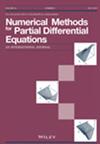强锚定条件下的 de Gennes-Cahn-Hilliard 能量最小值
IF 1.7
3区 数学
Q1 MATHEMATICS, APPLIED
引用次数: 0
摘要
在本文中,我们利用 Nehari 流形和具有 Dirichlet 边界条件的负拉普拉奇的特征值问题,分析研究了有界域上具有四元双阱势和 Dirichlet 边界条件的 de Gennes-Cahn-Hilliard 能量的最小值。我们的分析揭示了一种由边界值和分岔参数决定的分岔现象,分岔参数描述了隔离二元混合物两相的过渡层的厚度。具体来说,当边界值与纯相的平均值精确一致,且分岔参数超过或等于临界阈值时,最小化器就会呈现唯一的形式,代表均相状态。反之,当分岔参数低于该临界值时,就会出现两个对称的最小化子。如果边界值大于或小于纯相的平均值,对称性就会被打破,从而产生一个独特的最小化器。此外,我们还结合边界条件和 de Gennes-Cahn-Hilliard 能量的特征,推导出了这些最小化器的边界。本文章由计算机程序翻译,如有差异,请以英文原文为准。
Minimizers for the de Gennes–Cahn–Hilliard energy under strong anchoring conditions
In this article, we use the Nehari manifold and the eigenvalue problem for the negative Laplacian with Dirichlet boundary condition to analytically study the minimizers for the de Gennes–Cahn–Hilliard energy with quartic double‐well potential and Dirichlet boundary condition on the bounded domain. Our analysis reveals a bifurcation phenomenon determined by the boundary value and a bifurcation parameter that describes the thickness of the transition layer that segregates the binary mixture's two phases. Specifically, when the boundary value aligns precisely with the average of the pure phases, and the bifurcation parameter surpasses or equals a critical threshold, the minimizer assumes a unique form, representing the homogeneous state. Conversely, when the bifurcation parameter falls below this critical value, two symmetric minimizers emerge. Should the boundary value be larger or smaller from the average of the pure phases, symmetry breaks, resulting in a unique minimizer. Furthermore, we derive bounds of these minimizers, incorporating boundary conditions and features of the de Gennes–Cahn–Hilliard energy.
求助全文
通过发布文献求助,成功后即可免费获取论文全文。
去求助
来源期刊
CiteScore
7.20
自引率
2.60%
发文量
81
审稿时长
9 months
期刊介绍:
An international journal that aims to cover research into the development and analysis of new methods for the numerical solution of partial differential equations, it is intended that it be readily readable by and directed to a broad spectrum of researchers into numerical methods for partial differential equations throughout science and engineering. The numerical methods and techniques themselves are emphasized rather than the specific applications. The Journal seeks to be interdisciplinary, while retaining the common thread of applied numerical analysis.

 求助内容:
求助内容: 应助结果提醒方式:
应助结果提醒方式:


